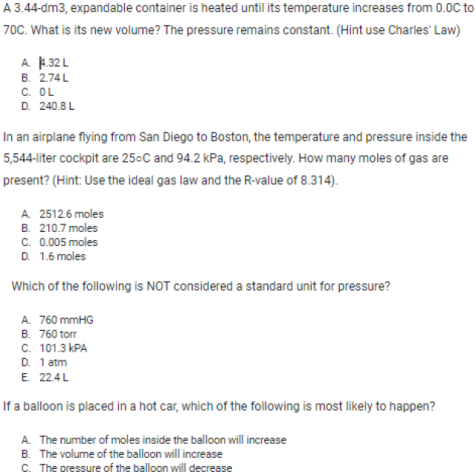use picture below please help?
2020-04-20 3:56 pm
gas law

回答 (1)
2020-04-20 4:42 pm
✔ 最佳答案
1.Original: V₁ = 3.44 dm³, T₁ = (273 + 0) K = 273 K
New: V₂ = ? dm³, T₂ = (273 + 70) K = 343 K
Charles' Law: V₁/T₂ = V₂/T₂
Then, V₂ = V₁ × (T₂/T₁)
New volume, V₂ = 3.44 × (343/273) dm³ = 4.32 dm³ = 4.32 L
The answer: A. 4.32 L
====
2.
Pressure, P = 94.2 kPa
Volume, V = 5544 L
Temperature, T = (273 + 25) K = 298 K
Gas constant, R = 8.314 L kPa / (mol K)
Gas law: PV = nRT
Then, n = PV/(RT)
No. of moles, n = 94.2 × 5544 / (8.314 × 298) mol = 210.8 mol ≈ 210.7 mol
The answer: B. 210.7 mol
====
3.
The answer: E. 22.4 L
"L" is a unit for volume, but not pressure.
====
4.
The balloon contains a fixed amount of gas at constant pressure. According to Charles' law, the volume of the balloon is directly proportional to the temperature. As the temperature in the hot car is high, the volume of the balloon will increase.
The answer: B. The volume of the balloon will increase.
收錄日期: 2021-05-01 09:37:12
原文連結 [永久失效]:
https://hk.answers.yahoo.com/question/index?qid=20200420075643AAXnSjf
